|
Pickett's Charge
Battle of Gettysburg
Pickett’s Charge and Battle of Gettysburg
| View of Seminary Ridge from Cemetery Ridge |
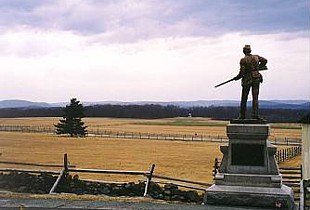
|
| Pickett's Charge, Gettysburg NMP |
Introduction
The infantry assault was preceded by a massive artillery bombardment that
was meant to soften up the Union defense and silence its artillery, but was largely ineffective. Approximately 12,500 men
in nine infantry brigades advanced over open fields for three-quarters of a mile under heavy Union artillery and rifle fire.
Although some Confederates were able to breach the low stone wall that shielded many of the Union defenders, they could not
maintain their hold and were repulsed with over 50% casualties, a decisive defeat that ended the three-day battle and Lee's
campaign into Pennsylvania.
While the Union lost about 1,500 killed and wounded, the Confederate casualty
rate was over 50%. Pickett's division suffered 2,655 casualties (498 killed, 643 wounded, 833 wounded and captured, and 681
captured, unwounded). Pettigrew's losses are estimated to be about 2,700 (470 killed, 1,893 wounded, 337 captured). Trimble's
two brigades lost 885 (155 killed, 650 wounded, and 80 captured). Wilcox's brigade reported losses of 200, Lang's about 400.
Thus, total losses during the attack were 6,555, of which at least 1,123 Confederates were killed on the battlefield, 4,019
were wounded, and a good number of the injured were also captured. Confederate prisoner totals are difficult to estimate from
their reports; Union reports indicated that 3,750 men were captured.
| Pickett's Charge and Gettysburg Battlefield Map |
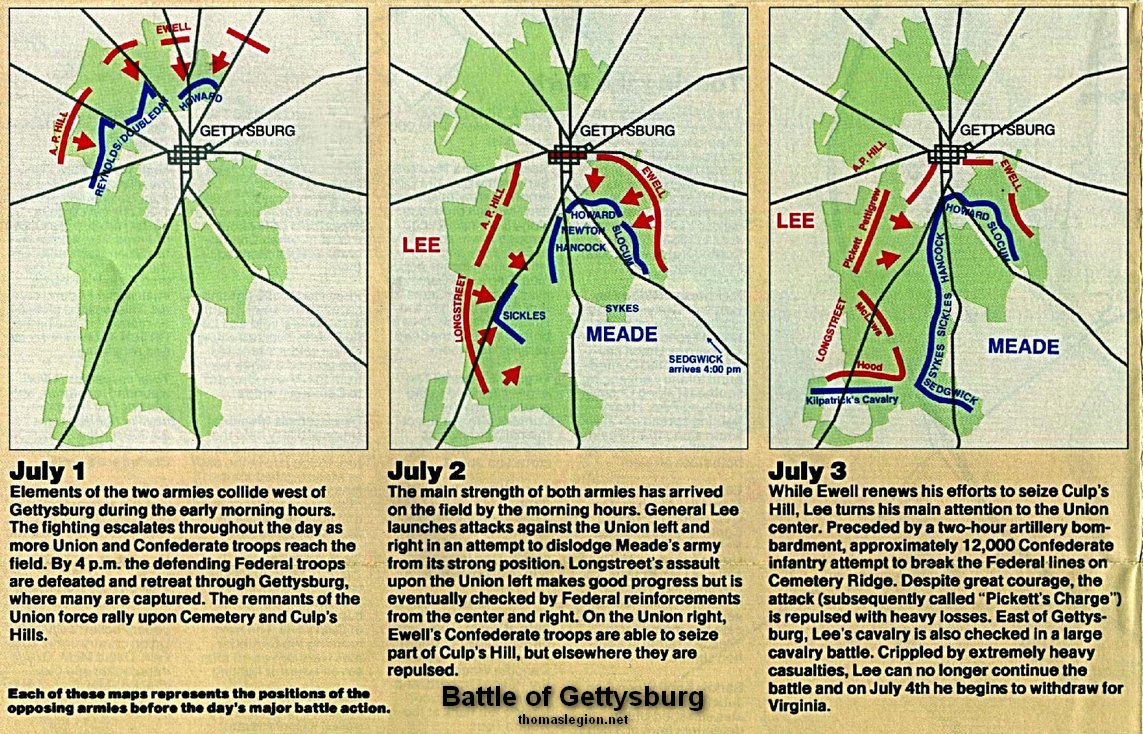
|
| Pickett's Assault, July 3, 1863 |
| Pickett's Charge Map |
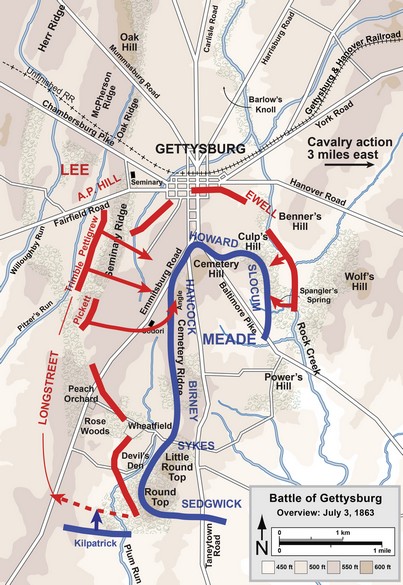
|
| Battle of Gettysburg and Pickett's Charge Map |
Pickett's Charge at Gettysburg
These fields are where "Pickett's Charge", the last Confederate attack of the battle occurred. Almost one mile of open ground lay between Seminary Ridge in the distance and Cemetery Ridge in the foreground. Confederate soldiers of General A.P. Hill's corps and General James Longstreet's corps occupied the distant woods on July 2, the trees screening the movement of artillery and infantry into position to prepare
for the afternoon's assault on the Union left flank on Cemetery Ridge, which began at 4 PM. Only Confederate skirmishers were
observed in these fields until 7 PM when General Ambrose Wright's Georgia brigade advanced from the woods across this wide
plain, striking Union troops centered around the Codori House on the Emmitsburg Road. Though initially successful, Wright's
men could not penetrate the Union line and were thrown back with severe losses. At dawn of July 3, these fields and pastures
were full of troops from both armies engaged in heavy skirmish fighting that lasted throughout the morning.
| Gen. Longstreet |

|
| Generals In Gray |
Promptly at 1 o'clock, two Confederate cannon of the Washington Artillery
of New Orleans were fired as a signal to begin the artillery bombardment prior to the infantry assault. Approximately 120
Southern cannon suddenly came to life, sending shot and shell into the Union line on Cemetery Ridge. Colonel Edward Porter Alexander recalled, "In another minute every gun was at work. The enemy were not slow in coming back at us, and the grand roar of nearly
the whole artillery of both armies burst in on the silence, almost as suddenly as the full notes of an organ would fill a
church. The enemy's position seemed to have broken out with guns everywhere and from Round Top to Cemetery Hill was blazing like a volcano. The air seemed full of missiles from every direction." For forty minutes the deadly duel with
Union cannoneers on Cemetery Ridge continued with no let up in the volume of shells or ear-splitting blasts. The sound of
the cannonade was so loud that it could be heard as far away as Harrisburg, Pennsylvania, a distance of 40 miles.
| Pickett's Charge |
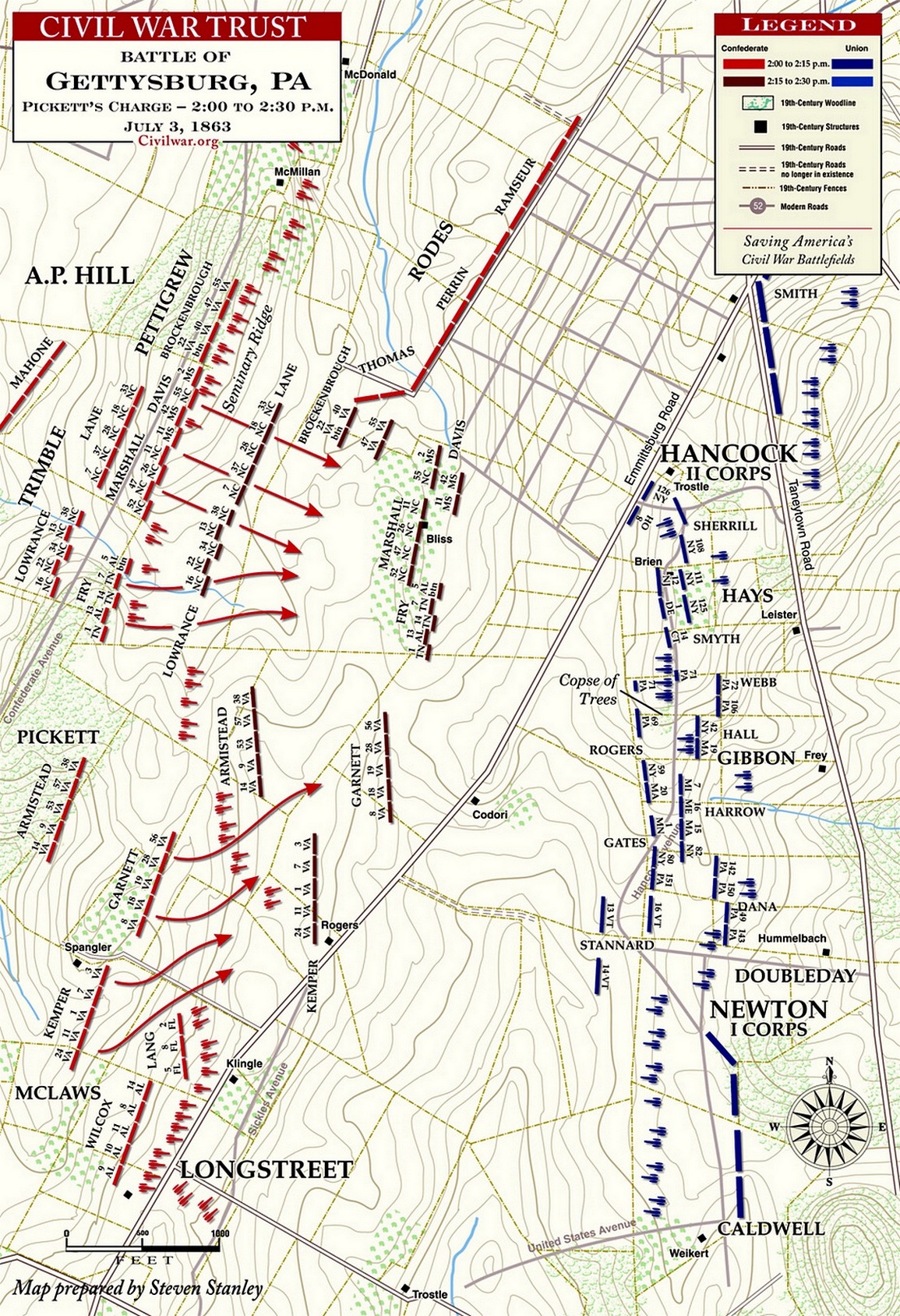
|
| Advance of Pickett's Division at Gettysburg on July 3, 1863 |
| Gen. Pickett |

|
| Generals In Gray |
General James Longstreet was tasked with command of the infantry in the last
great charge of the battle. General George Pickett's Division of Virginia soldiers, General Heth's Division (commanded by
General J.J Pettigrew), and two brigades of General Pender's Division (commanded by General Isaac Trimble), approximately
12,000 infantrymen, would make the initial charge. The troops would be followed by reinforcements including General Cadmus
Wilcox's Alabama brigade and Colonel David Lang's brigade of three Florida regiments. General Lee's last gamble for victory at Gettysburg now rested in the hands and hearts of these Southern infantrymen, about
to enter into one of the most desperate and famous charges in American history. After forty minutes of cannonading many of
the Union guns fell silent by order of General Henry Hunt, artillery chief of the Army of the Potomac. The slackening of fire was mistaken by Alexander for a general withdrawal and he scribbled a note to General Pickett: "For
God's sake, come quick... come quick, or my ammunition won't let me support you properly." Pickett carried the message to
General Longstreet, seated on a fence in Spangler's Woods near the location of the Virginia Monument. Sad and bitter, Longstreet could barely a nod a reply. The dashing Pickett
rode off to order his men forward while Longstreet remained on his fence, preferring not to watch the disaster about to befall
his troops.
"Up men and to your posts,"
shouted a joyous General Pickett. "Don't forget today that you are from Old Virginia!" His men cheered as they rushed into
formation. "Before us lay bright fields and fair landscape," a Confederate staff officer remembered as the Southern infantry
stood in perfect order, prepared to cross the mile of open farmland. At the command of "forward, march!" The huge formations
moved and each regiment was distinguishable by the red cloth battle flag of the Army of Northern Virginia. This massive parade
was suddenly rained upon by a shower of artillery shells as Union guns came back to life. Explosions ripped through the Confederate
ranks. Officers waved swords and shouted above the noise for the men to close the gaps. Guided by their flags, the Southerners
continued on toward Cemetery Ridge.
| The field of Pickett's Charge |
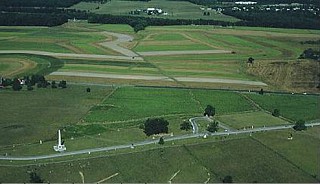
|
| Gettysburg NMP |
(Right) Photo of the field of Pickett's Charge. Pickett's, Pettigrew's, and Trimble's commands marched from
the distant line of trees to Cemetery Ridge, breaking the Union line at the Angle and "High Water Mark" in the foreground.
It was over within an hour. These fields were soon covered with the
survivors of "Pickett's Charge", some staggering from wounds and shock, some walking quietly with little reaction to the chaos
around them, and some near panic. Accompanied by Sir Arthur Fremantle, an observer from the British Army, General Longstreet
rode among them and spoke kindly to both officers and men. Fremantle also saw General Lee speak to the shocked survivors of
the charge. "All this will come out right in the end," the general said. "We'll talk it over afterwards; but in the meantime,
all good men must rally. We want all good and true men just now."
Today these quiet fields are traversed by hundreds of park visitors
eager to walk the same historic line of march where so many tramped to their deaths on that hot July afternoon. The trail
begins at Spangler Woods near the Virginia Monument
and takes visitors across the mile of open field, across the Emmitsburg Road
and up to the Angle, the central piece of contested ground. Here stands the small grove of trees- a mere clump of scrubby
trees and brush in 1863- that forever after has borne the name of the "High Water Mark".
| Pickett's Charge, July 3, 1863 |
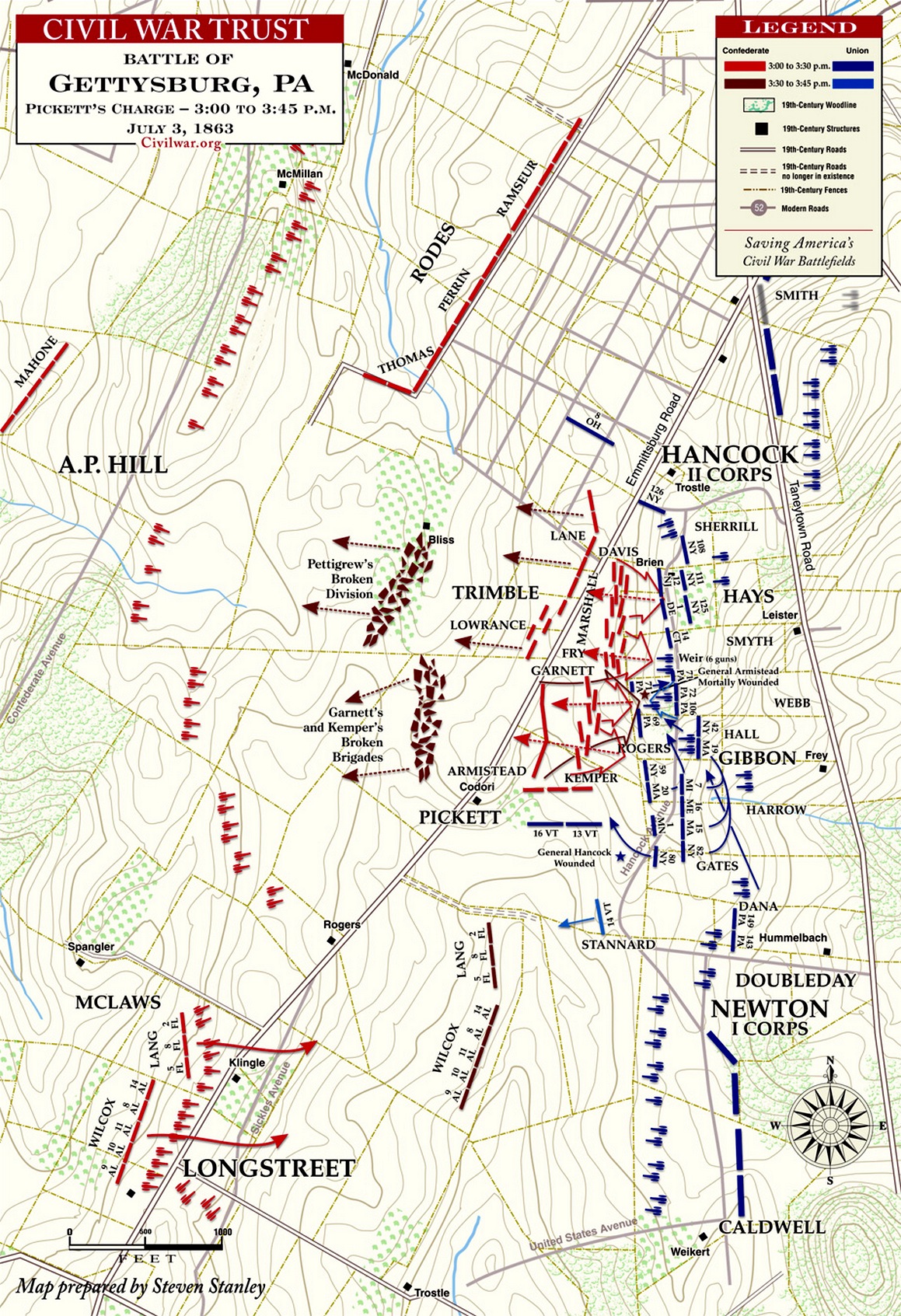
|
| Pickett's Division repulsed and shattered |
| The Virginia Monument |
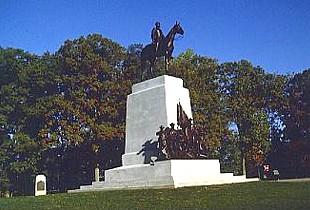
|
| Gettysburg NMP |
Located near the center of Seminary Ridge, the Virginia Monument is one
of the largest Southern monuments in the park and features a heroic-size equestrian statue of General Lee atop Traveller,
his favorite mount. On the base of the monument is a grouping of bronze figures representing the various backgrounds of the
soldiers who served under Virginia's flag. All of the figures are the work of sculptor F. William Sievers (1872-1966), whose
outdoor artistic work also includes two monuments in Richmond. The monument was unveiled and formally dedicated on June 8,
1917.
This location for the monument, overlooking the fields of Pickett's Charge,
was selected because it was here that General Lee witnessed the disastrous charge. Even in defeat, Lee was magnanimous. Rising
to the greatness that has symbolized him throughout history, the general placed full blame for the failure squarely on himself.
To a distraught General Pickett, Lee spoke words of comfort: "Come, General Pickett, this has been my fight, and upon my shoulders
rests the blame. The men and officers of your command have written the name of Virginia as high today as it has ever been
written before." It is no wonder that the Confederate soldiers who served under Lee gave him their undying loyalty and many
historians feel that this day at Gettysburg, as tragic as it was, may have been his finest hour.
Sources: National Park Service; Gettysburg National Military Park; Civil
War Trust; National Archives; Library of Congress.
Recommended Reading: Pickett's Charge,
by George Stewart. Description: The author has written
an eminently readable, thoroughly enjoyable, and well-researched book on the third day of the Gettysburg battle, July 3, 1863. An especially rewarding read if one has toured, or plans
to visit, the battlefield site. The author's unpretentious, conversational style of writing succeeds in putting the reader
on the ground occupied by both the Confederate and Union forces before, during and after
Pickett's and Pettigrew's famous assault on Meade's Second Corps. Continued below...
Interspersed
with humor and down-to-earth observations concerning battlefield conditions, the author conscientiously describes all aspects
of the battle, from massing of the assault columns and pre-assault artillery barrage to the last shots and the flight of the
surviving rebels back to the safety of their lines… Having visited Gettysburg several years ago, this superb volume makes me
want to go again.
Recommended Reading:
Pickett's Charge--The Last Attack at Gettysburg (Hardcover). Description: Pickett's Charge
is probably the best-known military engagement of the Civil War, widely regarded as the defining moment of the battle of Gettysburg and celebrated as the high-water mark of the Confederacy.
But as Earl Hess notes, the epic stature of Pickett's Charge has grown at the expense of reality, and the facts of the attack
have been obscured or distorted by the legend that surrounds them. With this book, Hess sweeps away the accumulated myths
about Pickett's Charge to provide the definitive history of the engagement. Continued below...
Drawing on
exhaustive research, especially in unpublished personal accounts, he creates a moving narrative of the attack from both Union and Confederate
perspectives, analyzing its planning, execution, aftermath, and legacy. He also examines the history of the units involved,
their state of readiness, how they maneuvered under fire, and what the men who marched in the ranks thought about their participation
in the assault. Ultimately, Hess explains, such an approach reveals Pickett's Charge both as a case study in how soldiers
deal with combat and as a dramatic example of heroism, failure, and fate on the battlefield.
Recommended Reading:
Pickett's Charge in History and Memory. Description: Pickett's Charge--the Confederates' desperate (and failed) attempt to break the Union
lines on the third and final day of the Battle of Gettysburg--is best remembered as the turning point of the U.S. Civil War.
But Penn State
historian Carol Reardon reveals how hard it is to remember the past accurately, especially when an event such as this one
so quickly slipped into myth. She writes, "From the time the battle smoke cleared, Pickett's Charge took on this chameleon-like
aspect and, through a variety of carefully constructed nuances, adjusted superbly to satisfy the changing needs of Northerners,
Southerners, and, finally, the entire nation." Continued below.
With
care and detail, Reardon's fascinating book teaches a lesson in the uses and misuses of history.
Recommended Reading: Last Chance For Victory: Robert E. Lee And
The Gettysburg Campaign. Description: Long after nearly fifty thousand soldiers shed their blood there,
serious misunderstandings persist about Robert E. Lee's generalship at Gettysburg.
What were Lee's choices before, during, and after the battle? What did he know that caused him to act as he did? Last Chance
for Victory addresses these issues by studying Lee's decisions and the military intelligence he possessed when each was made.
Continued below...
Packed with
new information and original research, Last Chance for Victory draws alarming conclusions to complex issues with precision
and clarity. Readers will never look at Robert E. Lee and Gettysburg the same way again.
Recommended Reading: Pickett's
Charge: Eyewitness Accounts At The Battle Of Gettysburg
(Stackpole Military History Series). Description: On
the final day of the battle of Gettysburg, Robert E. Lee ordered
one of the most famous infantry assaults of all time: Pickett's Charge. Following a thundering artillery barrage, thousands
of Confederates launched a daring frontal attack on the Union line. From their entrenched positions, Federal soldiers decimated
the charging Rebels, leaving the field littered with the fallen and several Southern divisions in tatters. Written by generals,
officers, and enlisted men on both sides, these firsthand accounts offer an up-close look at Civil War combat and a panoramic
view of the carnage of July 3, 1863.
Recommended Reading: The Artillery of Gettysburg (Hardcover). Description: The battle of Gettysburg in July 1863, the apex of the Confederacy's final major invasion
of the North, was a devastating defeat that also marked the end of the South's offensive strategy against the North. From
this battle until the end of the war, the Confederate armies largely remained defensive. The Artillery of Gettysburg is a
thought-provoking look at the role of the artillery during the July 1-3, 1863 conflict.
During the
Gettysburg
campaign, artillery had already gained the respect in both armies. Used defensively, it could break up attacking formations
and change the outcomes of battle. On the offense, it could soften up enemy positions prior to attack. And even if the results
were not immediately obvious, the psychological effects to strong artillery support could bolster the infantry and discourage
the enemy. Ultimately, infantry and artillery branches became codependent, for the artillery needed infantry support lest
it be decimated by enemy infantry or captured. The Confederate Army of Northern Virginia had modified its codependent command
system in February 1863. Prior to that, batteries were allocated to brigades, but now they were assigned to each infantry
division, thus decentralizing its command structure and making it more difficult for Gen. Robert E. Lee and his artillery
chief, Brig. Gen. William Pendleton, to control their deployment on the battlefield. The Union Army of the Potomac
had superior artillery capabilities in numerous ways. At Gettysburg,
the Federal artillery had 372 cannons and the Confederates 283. To make matters worse, the Confederate artillery frequently
was hindered by the quality of the fuses, which caused the shells to explode too early, too late, or not at all. When combined
with a command structure that gave Union Brig. Gen. Henry Hunt more direct control--than his Southern counterpart had over
his forces--the Federal army enjoyed a decided advantage in the countryside around Gettysburg. Bradley
M. Gottfried provides insight into how the two armies employed their artillery, how the different kinds of weapons functioned
in battle, and the strategies for using each of them. He shows how artillery affected the “ebb and flow” of battle
for both armies and thus provides a unique way of understanding the strategies of the Federal and Union
commanders.
Recommended
Reading:
ONE CONTINUOUS FIGHT: The Retreat from Gettysburg and the Pursuit of Lee's Army of Northern Virginia, July 4-14, 1863 (Hardcover) (June 2008). Description: The titanic three-day
battle of Gettysburg left 50,000 casualties in its wake, a
battered Southern army far from its base of supplies, and a rich historiographic legacy. Thousands of books and articles cover
nearly every aspect of the battle, but not a single volume focuses on the military aspects of the monumentally important movements
of the armies to and across the Potomac River. One Continuous Fight: The Retreat from Gettysburg and the Pursuit of Lee's Army of Northern Virginia, July
4-14, 1863 is the first detailed military history of Lee's retreat and the Union effort to catch and destroy the wounded Army
of Northern Virginia. Against steep odds and encumbered with thousands of casualties, Confederate commander Robert E. Lee's
post-battle task was to successfully withdraw his army across the Potomac River. Union commander George G. Meade's equally
difficult assignment was to intercept the effort and destroy his enemy. The responsibility for defending the exposed Southern
columns belonged to cavalry chieftain James Ewell Brown (JEB) Stuart. If Stuart fumbled his famous ride north to Gettysburg, his generalship during the retreat more than redeemed his
flagging reputation. The ten days of retreat triggered nearly two dozen skirmishes and major engagements, including fighting
at Granite Hill, Monterey Pass, Hagerstown, Williamsport, Funkstown,
Boonsboro, and Falling Waters. Continued below...
President
Abraham Lincoln was thankful for the early July battlefield victory, but disappointed that General Meade was unable to surround
and crush the Confederates before they found safety on the far side of the Potomac. Exactly what Meade did to try to intercept the fleeing Confederates, and how the
Southerners managed to defend their army and ponderous 17-mile long wagon train of wounded until crossing into western Virginia on the early morning of July 14, is the subject of this study.
One Continuous Fight draws upon a massive array of documents, letters, diaries, newspaper accounts, and published primary
and secondary sources. These long-ignored foundational sources allow the authors, each widely known for their expertise in
Civil War cavalry operations, to describe carefully each engagement. The result is a rich and comprehensive study loaded with
incisive tactical commentary, new perspectives on the strategic role of the Southern and Northern cavalry, and fresh insights
on every engagement, large and small, fought during the retreat. The retreat from Gettysburg
was so punctuated with fighting that a soldier felt compelled to describe it as "One Continuous Fight." Until now, few students
fully realized the accuracy of that description. Complimented with 18 original maps, dozens of photos, and a complete driving
tour with GPS coordinates of the entire retreat, One Continuous Fight is an essential book for every student of the American
Civil War in general, and for the student of Gettysburg in
particular. About the Authors: Eric J. Wittenberg has written widely on Civil War cavalry operations. His books include Glory
Enough for All (2002), The Union Cavalry Comes of Age (2003), and The Battle of Monroe's Crossroads and the Civil War's Final
Campaign (2005). He lives in Columbus, Ohio.
J. David Petruzzi is the author of several magazine articles on Eastern Theater cavalry operations, conducts tours of cavalry
sites of the Gettysburg Campaign, and is the author of the popular "Buford's Boys." A long time student of the Gettysburg
Campaign, Michael Nugent is a retired US Army Armored Cavalry Officer and the descendant of a Civil War Cavalry soldier. He
has previously written for several military publications. Nugent lives in Wells, Maine.
Recommended Reading:
General Lee's Army: From Victory to Collapse (Hardcover). Review: You cannot say that University of North Carolina professor Glatthaar (Partners in Command) did not do his homework in
this massive examination of the Civil War–era lives of the men in Robert E. Lee's Army of Northern Virginia. Glatthaar
spent nearly 20 years examining and ordering primary source material to ferret out why Lee's men fought, how they lived during
the war, how they came close to winning, and why they lost. Glatthaar marshals convincing evidence to challenge the often-expressed
notion that the war in the South was a rich man's war and a poor man's fight and that support for slavery was concentrated
among the Southern upper class. Continued
below...
Lee's army
included the rich, poor and middle-class, according to the author, who contends that there was broad support for the war in
all economic strata of Confederate society. He also challenges the myth that because Union forces outnumbered and materially
outmatched the Confederates, the rebel cause was lost, and articulates Lee and his army's acumen and achievements in the face
of this overwhelming opposition. This well-written work provides much food for thought for all Civil War buffs.
|

